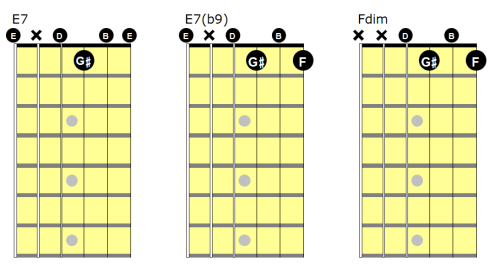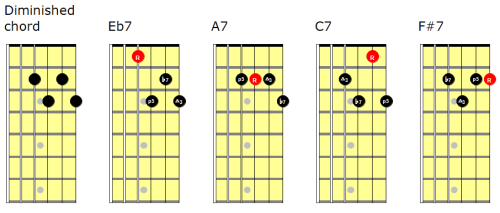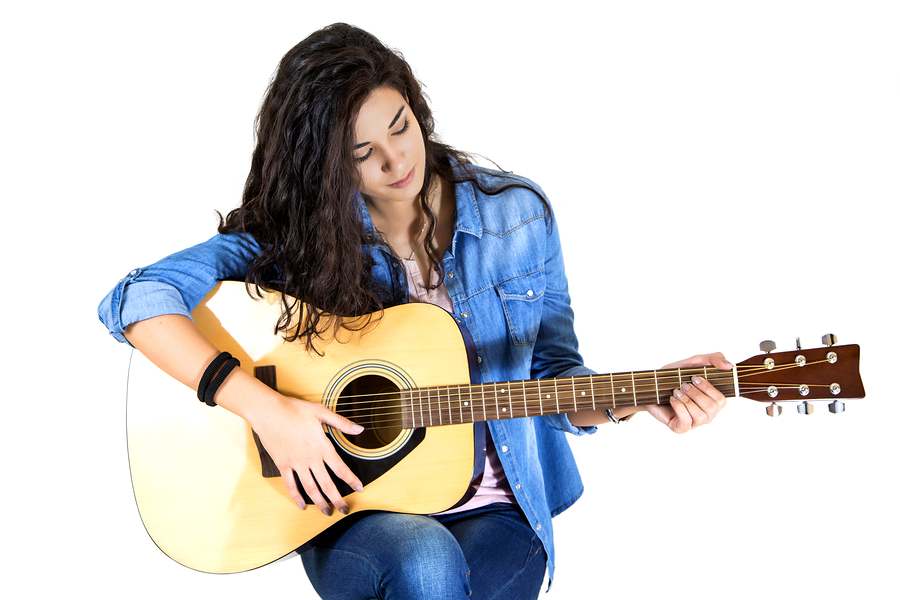Chords Guitar - Google Blog Search |
- This robotic <b>guitar</b> hand can help you master those complicated <b>chords</b>
- <b>Chord</b> voicings on <b>guitar</b> Pt2. Get dominant! | Ashdown <b>Guitar</b> Lessons
- The 8 Most Important Open <b>Guitar Chords</b> For Beginners
| This robotic <b>guitar</b> hand can help you master those complicated <b>chords</b> Posted: 06 Jun 2014 02:11 PM PDT If you've ever tried to learn how to play an instrument, you probably know that feeling when someone's breathing down your neck, barely letting you get a note out before they bombard you with more of their so-called "expertise." Well, for those of you looking to pick up the guitar or simply improve your skills, the new robotic guitar hand dubbed "RoboTar" may be the way to master those chord fingerings without having to endure your friend's unasked-for advice. RoboTar essentially does half the handwork involved in playing guitar for you by holding the strings down on the necessary frets to play individual notes or create a chord. Either way, all the human player has to do is pluck or strum the right strings at the right time. This is, in practice, easier said than done – the RoboTar doesn't automate the playing experience by any means. It brings the player halfway, effectively letting him or her focus solely on improving their strumming rhythm, endurance, and accuracy. The system runs by connecting to an accompanying app via Android or PC (through Bluetooth). The user can program the app to play any chord imaginable, even those that are physically impossible for the human hand to achieve on its own. Once the user has loaded into the program all of the chords they'll need, he or she arranges them in whatever order is desired. Then, once RoboTar is activated, all the user has to do is press down on a foot-pedal to trigger the device to move on to the next note or chord in the sequence. Take note, though: The RoboTar can only work on a guitar's first four frets. Kevin Krumwiede came up with the idea for the RoboTar — which is about midway through its Kickstarter campaign's funding period — when he was inspired to help his disabled father pick up the guitar again. Krumwiede's father was only 49 when he had a stroke which took away his ability to finger chords. But because RoboTar so effectively takes care of holding chord and note fingerings, his father is playing again. Krumwiede's device is interchangeably designed for both left- and right-handed strumming. The Kickstarter page explains that the RoboTar has many potential applications ranging from music therapy, to assisting fully functional players wishing to learn how to play and sing at the same time. Krumwiede's invention only has 15 days to gather a pretty steep $225,000. But even if RoboTar doesn't come to fruition as a result of this particular crowdfunding effort, the fact that Krumwiede's father is playing again with the help of a prototype indicates that we're already at the cusp of a new, robotically assisted world. DT  Alex Tretbar, audio/video intern, is a writer, editor, musician, gamer and sci-fi nerd raised on EverQuest and Magic: The Gathering. He studied English and Journalism at the University of Kansas, working for local media such as the Kansan and KJHK 90.7 FM. After writing for a Kansas City trade journal post-graduation, Alex took up traveling and eventually settled in the Pacific Northwest. |
| <b>Chord</b> voicings on <b>guitar</b> Pt2. Get dominant! | Ashdown <b>Guitar</b> Lessons Posted: 06 Jun 2014 01:38 AM PDT June 6, 2014 by andyevans01 On a previous post I showed chord voicing options for dimished chords, using different combinations of strings. Here's the promised follow up, showing how you can use this knowledge to derive voicings for dominant chords. Dominant chords are hugely important, not just in their own right but also as a basis for building much more complex and interesting chords. You can add just about any other note to the basic dominant and get a cool new sound. One of the most frequent additions is the b9 (flat ninth). As an example that would mean adding F to an E7 chord. That's just what the first two diagrams show. To keep things simple I've left out the low B, 2nd fret on the 5th string; but the open 2nd string gives you a high B, so the sound is still there. Go ahead and play the first two chords – it's vital to get the sound into your ears and mind. Hear the sound of that F adding some bite to the chord? Here's the thing. If you simply leave out the E (6th string) from the E7(b9) what you're left with is a diminished chord – as in the third diagram. You can think of a diminished chord as a dominant 7(b9) chord without it's root. Look at that third diagram. It's pretty clear that if you lower the F by one fret you get back to a four-string version of plain old E7. That gives us the key to unlock the secret: in a diminished chord, lowering any note by one fret produces a dominant 7th. Let's look at the dimished chord voicing on string set 4-3-2-1. From the position shown the diminished shape yields four different dominant 7ths when you lower each note in turn. This means that for each of the eight diminished voicings in the previous post you can get 4 dominant 7th voicings. Put it another way, for every dominant 7th chord you can find 8 different 4-string voicings if you're clear on the diminished shapes. I'll leave you to experiment with finding them and developing your own fingerings. Have fun! |
| The 8 Most Important Open <b>Guitar Chords</b> For Beginners Posted: 15 May 2014 04:14 PM PDT Bigstock photo Well learning chords and strumming songs is the first thing you want to work on. The chords are the building blocks for your songs, they give you the harmony. The strumming delivers the rhythm and together they are the accompaniment for your or someone elses singing voice which in turn provides the melody. The 8 chords every beginner guitar player should learn first are: C – A – G – E – D – Am – Em – Dm. (you can memorize the first 5 open major chords by the word CAGED) With these chords alone you can play an endless amount of songs. For example there are about a zillion songs that use this chord progression: G – D – Em – C (also called the I – V – vi – IV progression). Songs like "You're beautiful" by James Blunt, "With or without you" by U2 and "She will be loved" by Maroon 5 can all be played with just these 4 chords. Not all of these songs are originally in the key of G but you could easily fix with the help of a capo and play it in the appropriate key. The open chords are also the starting point and components for the more advanced chords that follow like barre chords. All barre chords are derived from open chords. But that is for another post. For now check out and learn these 8 treasures to build your most important chord vocabulary:
The numbers on the dots in the chord diagrams above indicate the finger positioning: The best way to learn these chords is to apply them to songs to get you all fired up. Start with three chord songs to begin with and later when you feel more comfortable playing and switching between chords you can try some four chord songs. Here are some pointers to focus on when practicing chords: Tips: Have a great day! "Three chords and the truth, that's what a country song is" ~ Willie Nelson Join the Guitarhabits facebook page to keep up with the latest posts, guitar lesson videos, tips, tricks and other news about Guitarhabits. |
| You are subscribed to email updates from Chords Guitar - Google Blog Search To stop receiving these emails, you may unsubscribe now. | Email delivery powered by Google |
| Google Inc., 20 West Kinzie, Chicago IL USA 60610 | |


 Where do you start when you want to learn to play guitar?
Where do you start when you want to learn to play guitar?




0 comments:
Post a Comment